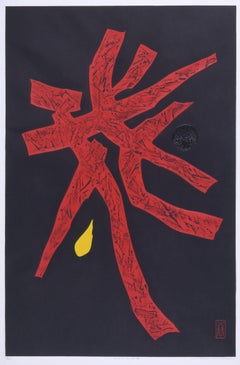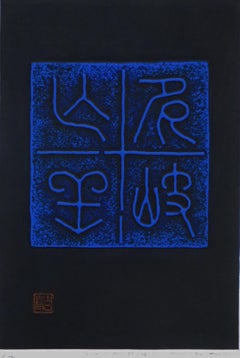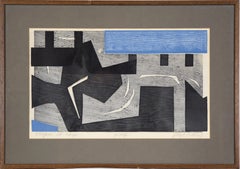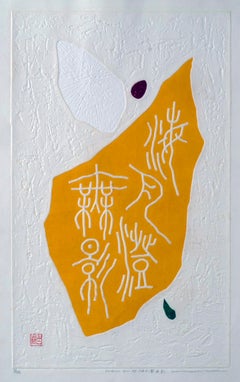This is original watercolor over a limited edition woodcut political poster. hand signed, dated and numbered. it bears similarity to works by Alexander Calder. Employing a star and abstract design.
Katherine Porter is an American artist born in Cedar Rapids, Iowa in 1941. She received her BA from Colorado College in 1963. Katherine Porter received an honorary doctorate from Colby College. She has shown twice in the Whitney Biennial and solo exhibitions at the Knoedler Gallery in London, the Nina Nielsen Gallery in Boston, and the Andre Emmerich and Salander-O'Reilly Galleries in New York. Her work is in the collections of the Metropolitan Museum of Art, Museum of Modern Art, Whitney Museum of American Art, Museum of Fine Arts in Boston, and the Tel Aviv Museum and Bezalel Museum in Jerusalem. (Katherine Page Porter, Katherine Pavlis Porter)
Her exhibitions include biennials in 1976 and 1981 at the Whitney Museum of American Art in New York City; 1980 at the San Francisco Museum of Fine Arts; 1981, Dartmouth College, Hanover, New Hampshire; 1985, Brandeis University, Waltham, Massachusetts; and 1987 at the Sidney Janis Gallery, New York City. Classic Americana. American Abstract Expressionism. Early Pattern and Decoration piece, The movement was championed by the gallery owner Holly Solomon. The P&D movement wanted to revive an interest in minor forms such as patterning which at that point was equated with triviality. The prevailing negative view of decoration was one not generally shared by non-Western cultures, The Pattern and Decoration movement was influenced by sources outside of what was considered to be fine art. Blurring the line between art and design, many P&D works mimic patterns like those on wallpapers, printed fabrics, and quilts. There is a close connection between the Pattern and Decoration movement and the Feminist art movement. The P&D movement arose in opposition to the Minimalist and Conceptualist movements. Mary Grigoriadis
Valerie Jaudon, Joyce Kozloff, Miriam Schapiro, Robert Zakanitch all worked in this same vein.
SELECTED SOLO EXHIBITIONS
Galerie Hubert Winter, Vienna, Austria
Victoria Munroe Fine Art, Boston, MA
Meridian Gallery, San Francisco, CA
Salander O’Reilly Gallery, New York, NY
Bowdoin College Museum of Art, Brunswick, ME
Andre Emmerich Gallery, New York, NY
Knoedler Gallery, London
Sidney Janis Gallery, New York, NY
Pace Gallery, Addison, ME
Dartmouth College, Hanover, NH (drawings)
Harcus Krakow Gallery, Boston, MA
SELECTED GROUP EXHIBITIONS
Contemporary Landscape Painting, Nagoya/Boston Museum of Art, Nagoya, Japan
From the Collection of Edward Broida, Palm Beach Art Museum, Palm Beach, FL
Abstraction Per Se (through January 1993), Pratt Manhattan Gallery, NY
Painting Self-Evident (Curator), Picolo Spoleto Festival, Charleston, SC
Art on Paper 1990, Weatherspoon Art Gallery, The University of North Carolina,
Museo Barjola, Gijon, Spain; Calouste Gulbenkian Foundation, Lisbon, Portugal;
Pratt Manhattan Gallery, NY
Sightings, Instituto de Estudios Norteamericanos, Barcelona; Casa Revilla, Valladolid, Invitational, New Britain Museum of American Art, New Britain, CT
Atelier Project, Neuberger Museum, SUNY Purchase, NY
Landscape Show, Allan Frumkin Gallery, NY
Rethinking the Avant-Garde, by Jonathan Fineberg, The Katonah Gallery, NY Nancy Hoffman Gallery, NY
Group Show, Van Abbemuseum, Eindhoven, Holland
Contemporary Drawings, Museum of Modern Art, New York, NY
International Survey of Recent Painting and Sculpture, Museum of Modern Art, NY
Modern Expressionist: German, Italian, & American Painters, Sidney Janis Gallery, NY
American Women Artists, Part II: Younger Generation, Sidney Janis Gallery, NY
Contemporary Works on Paper, Frumkin-Adams Gallery, NY
Hassam Speicher Purchase Fund Exhibition, American Academy of Arts and Letters, NY
The End of the World: Contemporary Visions of the Apocalypse, The New York Museum of Contemporary Art, NY
Recent Acquisitions, Museum of Modern Art, New York, NY
Homage to Arthur Dove, Hobart and William Smith Colleges, Geneva, NY
Six Painters, The Hudson River Museum, Yonkers, NY
Twenty New York Painters, Institute of Contemporary Art, Philadelphia, PA
74th American Exhibition, The Art Institute of Chicago, Chicago, IL
Abstract Painting, Women’s Caucus, NY
Biennial, Whitney Museum of American Art, New York
Spoleto Choice, Spoleto Festival, Charleston, SC
From Women’s Eyes, Rose Art Museum, Brandeis University, Waltham, MA
Theodoran, Solomon R. Guggenheim Museum, New York, NY
Three If By Air, Obelisk Gallery, Boston, MA
Betty Parsons Collection, Finch College, New York, NY
SELECTED PUBLIC COLLECTIONS
Addison Gallery of American Art, Andover, MA
Albertina Museum, Vienna, Austria
California Palace of the Legion of Honor (Achenbach Foundation), San Francisco, CA
Detroit Art Institute, Detroit, MI
Fogg Art Museum, Harvard University, Cambridge, MA
Gemeentsmuseum of the Hague, The Hague, Netherlands (permanent installation)
Solomon R. Guggenheim Museum, New York, NY
High Museum of Art, Atlanta, GA
Houston Museum of Fine Art, Houston, TX
Massachusetts Institute of Technology, Cambridge, MA
Metropolitan Museum of Art, New York, NY
Mount Holyoke...




